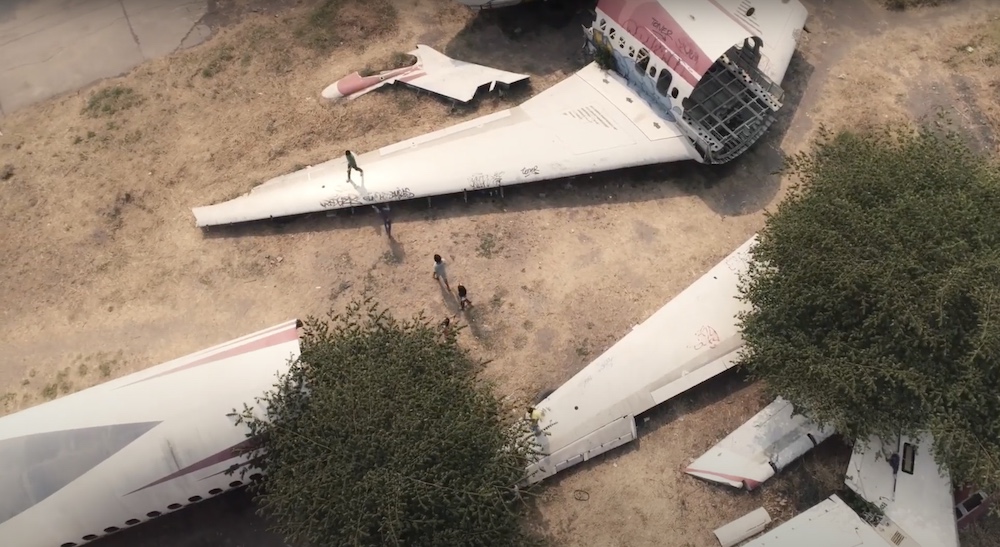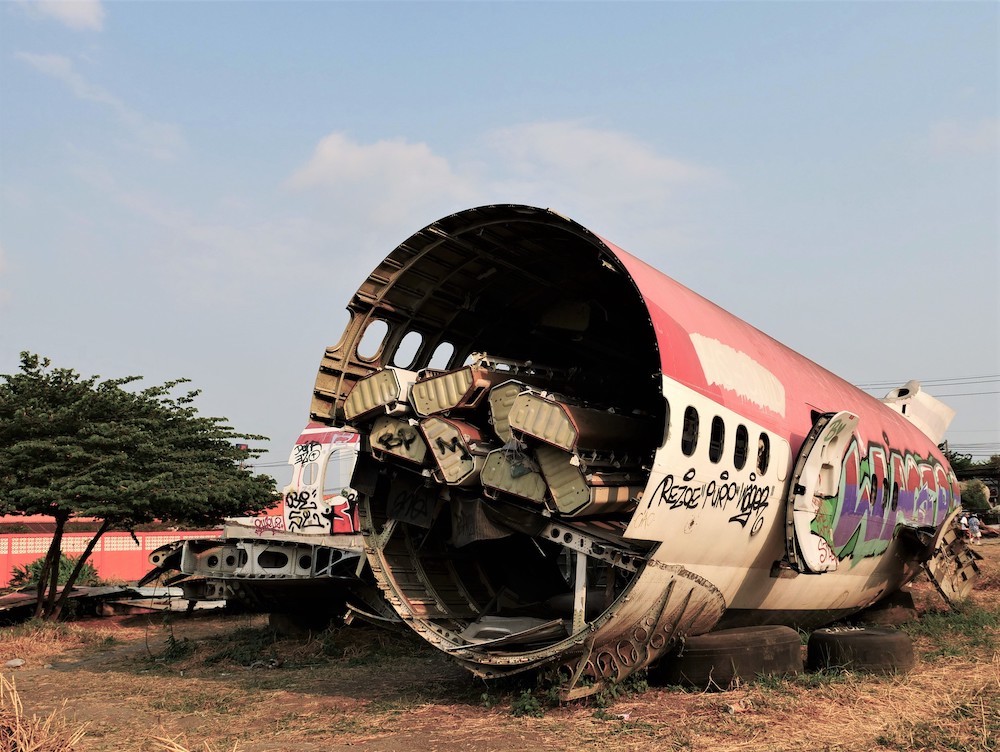The relationship between people and their junk is a curious one.
Just how oddly intertwined these two things can be is uncovered in the new documentary Scrap. Director Stacey Tenenbaum takes the long view, travelling from the depths of the Georgia hills to an airplane graveyard in Thailand. Along the way, she details the ways that old stuff can be transformed into something not only useful, but beautiful.
Purely as an investigation into the tenebrous loveliness of rust, the film is chock-a-block with visual pleasure. We float alongside retired trolleys and peer into the rotting husks of muscle cars spotted with moss and lichen. It is easy to simply waft along with the easeful flow of the film, but a harder message lurks beneath the lilting images. The way back from irrelevance and obsolescence demands work. Often the hard, dirty and dangerous variety.
That humans use and then chuck endless amounts of stuff isn’t exactly news, but the film takes a different approach to the cycle of junking things once they’ve reached the end of their active life. Tenenbaum shows us there is usefulness in the saddest old hulks of refuse, including a downed plane, a wizened train or an ancient phone booth.
One of the most charming segments takes as its subject the transformation of the iconic red phone booths familiar to any anglophile. Tony Inglis purchased more than 2,000 of the decommissioned booths and set about bringing them back to life: scraping off decades of buckled paint, replacing broken glass, slowly restoring dignity and handsomeness. The refurbished booths are put to a variety of new functions, everything from film props to miniature libraries to coffee kiosks.
There is something deeply soothing, even redemptive, about watching a person attend to the act of restoration with care and precision. Surely if this ancient crusty thing can be brought back to a state of shining glory, humans can also be returned to a state of a wholeness.
The film is as much about objects as it is about the people who love them. In Kenosha, Wisconsin, Ed Metka recounts his childhood fascination for streetcars, explaining that he watched the operators so carefully that by the age of five, he felt fully capable of driving the trolleys himself. After a lifetime of passion for streetcars, Metka met his wife some 61 years after the pair graduated (unbeknownst to each other) from the same high school. As he explains, they had three happy years before she passed.
The tenacity of metal, able to continue long after fragile human bodies have ended, is the subject of South Dakotan artist John Lopez’s metal sculptures. Composed of old tractor parts, bits of machinery and rusty lengths of chain, Lopez welds these disparate materials into larger-than-life figures of buffalo, tigers and draft horses. In a stunning testimony to his late father, he even creates an ancient gnarled tree covered with delicate pink metal petals.
As he explains, part of his inspiration came from the custom of old farmers dragging broken pieces of equipment up to the top of hills. Poised against the landscape, they stood like dinosaurs of old, markers of a time and place — as well as a lifetime of work. The intent was that these relics would take on a new life as conversation pieces and continue to be of service.
In another part of the world, abandoned machines become a home for families and a source of income. In Thailand, Fah Boonsong and her kids and grandkids live in a hollowed-out jumbo jet airliner among many spread across a field.
Tourists pay to take photographs with the derelict planes, and this money becomes a source of income for the family. As the kids bounce up and down on the wings of the permanently downed aircraft, their grandmother explains how she took over being the caretaker of the so-called “airplane graveyard.” Though she takes issue with the word “graveyard,” insisting that this isn’t a place of dead things but a vibrant community, alive with kids laughing and playing.

Resurrection is also the subject of Tchely Hyung-Chul Shin, an architect who works between South Korea and France. His architectural firm repurposes sections of old tankers and cargo ships into churches and other structures. Freed from rusting turpitude and transformed into soaring vaulted spaces, ships’ hulls become things of airy beauty, ribbed like the inside of a whale.
But such startling transformations are not easy.
The film does due diligence in capturing the gritty, rough work of cutting massive ships into their component parts. Retired vessels are sourced around the globe, but the reconstruction takes place mainly in Spain where a team of international shipwrights disassemble the boats. In extraordinary scenes, the behemoths are dragged out of water, turned on end and sliced into parts. As Shin explains, wiping away decades of accumulated rust from a section of hull, he feels connected to these old aquatic warriors like he does members of his own family.
Meanwhile in the U.S., the disintegrating hulks of old cars emerge out of the landscape of White, Georgia, like they were some new kind of growth. As the camera snakes through the 14-hectare site where more than 4,500 vehicles have found permanent parking spaces, curious sites emerge from the gloom. Atop a 1950s roadster heaped high with pine needles, an abandoned doll reaches out. Some vehicles have rested in place for so long that trees have grown through the engine blocks. It’s kind of beautiful and more than a little eerie.
As proprietor Dean Lewis says, the White junkyard is a kind of a museum. “It’s art, nature and history,” he says. Lewis inherited the place from his parents who started it as a used car lot in 1931, but since then it has evolved into something more akin to a kingdom of decay. From the hand-painted signs that declare “The Meaning of Life is to give Life Meaning” to the worn dirt paths that carve through the woods, the place is a distinctly rustic affair. The constellations of automotive rust possess great beauty, patterns and colours stippling the metal exteriors like a modernist painting. It is both lovely and unbearably sad.
In other parts of the world, the scale of disposable culture takes on epic proportions. In Delhi, old cellphones and televisions are dismantled by workers making a living by stripping the components parts out of junked technology. Photographer Saumya Khandelwal documents the lives of the workers, explaining that her images are driven by a need to do something active in the midst of the onslaught and juggernaut of waste: “When there are things that bother me, the only thing I can do is photograph it and put it out.”
Scrap is not covering new territory; there have been a number of films that have ploughed similar subject matter. And the film occasionally falls victim to a number of documentary tropes, like the overuse of drone shots, a tinkling, spare score and the easy romanticism of remote exotic locations. Although it doesn’t drift entirely into the poverty porn, it trembles on the edge. It’s a little floaty and soft in places where it should be hard.
But the intermingling of decay and new life makes for an interesting conjunction of opposing forces. The sheer magnificence of elemental, brutalist scrap remade into things both functional and beautiful is a reminder that almost anything can be brought back from the brink with enough care and love. Even the planet itself.
‘Scrap’ is screening at the Rio Theatre in Vancouver on Oct. 22 with the filmmaker in attendance. The film will also be broadcast on CBC on Nov. 6. ![]()
Read more: Art, Film, Environment
















Tyee Commenting Guidelines
Comments that violate guidelines risk being deleted, and violations may result in a temporary or permanent user ban. Maintain the spirit of good conversation to stay in the discussion.
*Please note The Tyee is not a forum for spreading misinformation about COVID-19, denying its existence or minimizing its risk to public health.
Do:
Do not: